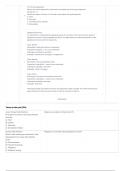Exam (elaborations)
Chamberlain College of Nursing - NR 507 Week 4 midterm > Set 1 (2024/2025); Attempt Score: 116 Out of 120.
- Course
- Institution
Chamberlain College of Nursing - NR 507 Week 4 midterm > Set 1 (2024/2025); Attempt Score: 116 Out of 120.
[Show more]



